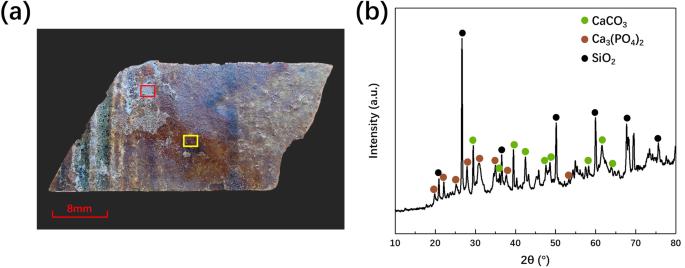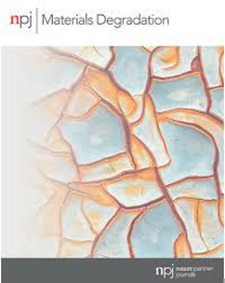The corrosion mechanism of lead-glazed pottery in Han dynasty
IF 6.6
2区 材料科学
Q1 MATERIALS SCIENCE, MULTIDISCIPLINARY
引用次数: 0
Abstract
Ancient pottery, having endured prolonged burial in soil, invariably underwent the process of glaze corrosion. The micromorphology and structural composition of four lead-glazed pottery fragments dating back to the Han Dynasty, excavated in the Qinhan New Town within Xixian New area of Xi’an are elucidated by comprehensive analysis method. The results reveal that the corrosion products predominantly comprised PbCO3, Pb3(PO4)2, CaCO3, and Ca3(PO4)2. Concurrently, the presence of organic substances exhibiting characteristic self-excitation fluorescence in the cracks of the sample is identified through fluorescence microscopy and Fourier infrared spectroscopy. Through a comparative analysis of well-preserved and severely corroded samples, taking into account compositional analysis, observations of corrosion morphology, and the characteristics of corrosion products, it is deduced that the primary corrosion mechanisms involve chemical corrosion, microbial corrosion, and crack corrosion. This study provides a comprehensive depiction of glaze corrosion process inherent to lead-glazed pottery and establishes corresponding corrosion models.

汉代铅釉陶的腐蚀机理
古代陶器在土壤中长期埋藏,必然会经历釉面腐蚀的过程。本研究采用综合分析方法,对西安西咸新区秦汉新城出土的四件汉代铅釉陶器残片的微观形态和结构组成进行了阐释。结果表明,腐蚀产物主要包括 PbCO3、Pb3(PO4)2、CaCO3 和 Ca3(PO4)2。同时,通过荧光显微镜和傅里叶红外光谱分析,确定了样品裂缝中存在有机物质,并表现出特征性的自激发荧光。通过对保存完好和严重腐蚀的样本进行对比分析,并结合成分分析、腐蚀形态观察和腐蚀产物特征,推断出主要腐蚀机制包括化学腐蚀、微生物腐蚀和裂纹腐蚀。这项研究全面描述了铅釉陶器固有的釉腐蚀过程,并建立了相应的腐蚀模型。
本文章由计算机程序翻译,如有差异,请以英文原文为准。
求助全文
约1分钟内获得全文
求助全文
来源期刊

npj Materials Degradation
MATERIALS SCIENCE, MULTIDISCIPLINARY-
CiteScore
7.80
自引率
7.80%
发文量
86
审稿时长
6 weeks
期刊介绍:
npj Materials Degradation considers basic and applied research that explores all aspects of the degradation of metallic and non-metallic materials. The journal broadly defines ‘materials degradation’ as a reduction in the ability of a material to perform its task in-service as a result of environmental exposure.
The journal covers a broad range of topics including but not limited to:
-Degradation of metals, glasses, minerals, polymers, ceramics, cements and composites in natural and engineered environments, as a result of various stimuli
-Computational and experimental studies of degradation mechanisms and kinetics
-Characterization of degradation by traditional and emerging techniques
-New approaches and technologies for enhancing resistance to degradation
-Inspection and monitoring techniques for materials in-service, such as sensing technologies
文献相关原料
| 公司名称 | 产品信息 | 采购帮参考价格 |
|---|
 求助内容:
求助内容: 应助结果提醒方式:
应助结果提醒方式:


